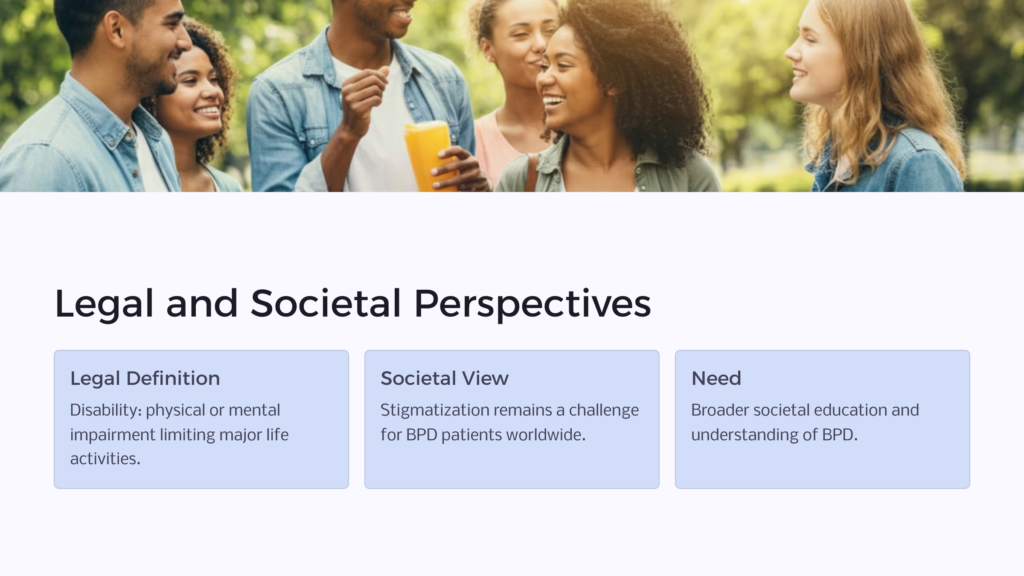Borderline Personality Disorder (BPD) is a serious mental health disorder that emanates from a pattern of ongoing instability in moods, behavior, self-image, and functionality. This article aims to delve into a comprehensive discussion about BPD, focusing on its understanding, impacts, and management from both societal and individual perspectives. We will also delve into the question of whether BPD should be considered a disability, and what this classification means for those affected.
Section 1: Understanding Borderline Personality Disorder

Borderline Personality Disorder is a mental illness often caused by a combination of genetic, brain, environmental, and social factors. These can include a family history of the disorder, brain abnormalities, traumatic life events, and a history of child abuse. BPD is often diagnosed through the presence of recurring patterns of instability in interpersonal relationships, self-image, and marked impulsivity observed in early adulthood. Interestingly, BPD affects approximately 1.4% of the adult population globally, proving the necessity of comprehensive understanding and treatment plans for those affected.
Section 2: Impact of Borderline Personality Disorder
BPD can leave a significant impact on an individual’s life. It can manifest in emotional instability, unstable relationships, and impulsive behavior, all of which affect both personal and professional spheres. Personal accounts from people living with this mental condition reveal a haunting struggle against a mind that feels uncontrollable, and a desperate wish for stability and normalcy. However, these narratives also highlight resilience, strength, and the determination to seek help and find viable coping mechanisms.
Section 3: Borderline Personality Disorder as a Disability
The classification of psychological disorders as ‘disabilities’ is a subject of ongoing debate. Proponents for considering BPD as a disability argue that the symptoms of this mental disorder significantly impair normal life functions and that social security disability benefits could greatly help patients. However, opponents argue that classifying BPD as a disability risks diminishing the resilience and adaptability of individuals living with the condition and might stigmatize them further.
Section 4: Legal and Societal Perspective of Borderline Personality Disorder

Legally, a disability is defined by some laws as a physical or mental impairment that substantially limits one or more major life activities. It’s important to note that societal, medical, and legal perspectives play a significant role in whether a mental health condition is classified as a disability. Unfortunately, societal stigmatization is a stark reality for many BPD patients worldwide, which underscores a need for broader societal education and understanding.
Section 5: Disability Benefits for Individuals with Borderline Personality Disorder

In certain jurisdictions, BPD is seen as a diagnosable mental health condition that may qualify for disability benefits. Such benefits are intended to provide financial and medical assistance to people who cannot work due to their mental illness. Navigating the process, however, can be a daunting task. Dealing with medical examinations, extensive paperwork, and often long waiting periods can present significant challenges for applicants.
Receiving Social Security Disability Insurance (SSDI) for Borderline Personality Disorder can be challenging due to the stringent criteria set by the Social Security Administration. To qualify for SSDI benefits, individuals with BPD must demonstrate severe functional limitations that prevent them from engaging in substantial gainful activity. This process often requires extensive medical documentation and proof of inability to work due to the disorder’s effects on daily functioning.
As a veteran, the VA will attach a disability rating to your condition which determines your chances of receiving VA disability benefits. The approval process for VA benefits or SSDI with mental illnesses like BPD can indeed be more complex due to the subjective nature of mental health impairments compared to physical disabilities. To apply for SSDI benefits for Borderline Personality Disorder, individuals must provide detailed medical documentation showcasing severe functional limitations hindering substantial gainful activity. This includes proof of inability to work due to the disorder’s impact on mental functioning, alongside navigating a challenging process involving medical examinations, paperwork, and waiting periods.

Section 6: Ways to Manage Borderline Personality Disorder
Managing BPD requires a multi-pronged approach of therapy, medication, lifestyle changes, and societal and personal support. Dialectical Behavior Therapy and Cognitive Behavioral Therapy are two therapeutic techniques that have shown promising results. Coupled with the right medication, these therapies can significantly aid symptom management. Additionally, involvement from family, friends, and wider social networks can provide emotional support and understanding that is crucial in managing BPD.
 Benefits.com Advisors
Benefits.com Advisors
With expertise spanning local, state, and federal benefit programs, our team is dedicated to guiding individuals towards the perfect program tailored to their unique circumstances.
Rise to the top with Peak Benefits!
Join our Peak Benefits Newsletter for the latest news, resources, and offers on all things government benefits.



















